A novel antisense RNA regulates at transcriptional level the virulence gene icsA of Shigella flexneri
- PMID: 20129941
- PMCID: PMC2879508
- DOI: 10.1093/nar/gkq025
A novel antisense RNA regulates at transcriptional level the virulence gene icsA of Shigella flexneri
Abstract
The virulence gene icsA of Shigella flexneri encodes an invasion protein crucial for host colonization by pathogenic bacteria. Within the intergenic region virA-icsA, we have discovered a new gene that encodes a non-translated antisense RNA (named RnaG), transcribed in cis on the complementary strand of icsA. In vitro transcription assays show that RnaG promotes premature termination of transcription of icsA mRNA. Transcriptional inhibition is also observed in vivo by monitoring the expression profile in Shigella by real-time polymerase chain reaction and when RnaG is provided in trans. Chemical and enzymatic probing of the leader region of icsA mRNA either free or bound to RnaG indicate that upon hetero-duplex formation an intrinsic terminator, leading to transcription block, is generated on the nascent icsA mRNA. Mutations in the hairpin structure of the proposed terminator impair the RnaG mediated-regulation of icsA transcription. This study represents the first evidence of transcriptional attenuation mechanism caused by a small RNA in Gram-negative bacteria. We also present data on the secondary structure of the antisense region of RnaG. In addition, alternatively silencing icsA and RnaG promoters, we find that transcription from the strong RnaG promoter reduces the activity of the weak convergent icsA promoter through the transcriptional interference regulation.
Figures


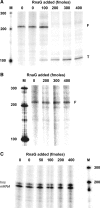
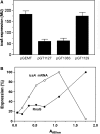
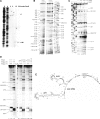
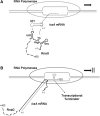
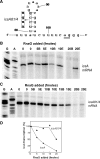

Similar articles
-
A multifactor regulatory circuit involving H-NS, VirF and an antisense RNA modulates transcription of the virulence gene icsA of Shigella flexneri.Nucleic Acids Res. 2011 Oct;39(18):8122-34. doi: 10.1093/nar/gkr521. Epub 2011 Jun 30. Nucleic Acids Res. 2011. PMID: 21724612 Free PMC article.
-
VirF Relieves the Transcriptional Attenuation of the Virulence Gene icsA of Shigella flexneri Affecting the icsA mRNA-RnaG Complex Formation.Front Microbiol. 2017 Apr 18;8:650. doi: 10.3389/fmicb.2017.00650. eCollection 2017. Front Microbiol. 2017. PMID: 28458662 Free PMC article.
-
Elucidation of the DNA-Binding Activity of VirF from Shigella flexneri for the icsA and rnaG Promoters and Characterization of the N-Terminal Domain To Identify Residues Crucial for Dimerization.J Bacteriol. 2023 Apr 25;205(4):e0001523. doi: 10.1128/jb.00015-23. Epub 2023 Mar 15. J Bacteriol. 2023. PMID: 36920216 Free PMC article.
-
Genetic modulation of Shigella flexneri 2a lipopolysaccharide O antigen modal chain length reveals that it has been optimized for virulence.Microbiology (Reading). 2003 Apr;149(Pt 4):925-939. doi: 10.1099/mic.0.26141-0. Microbiology (Reading). 2003. PMID: 12686635
-
Molecular and Cellular Mechanisms of Shigella flexneri Dissemination.Front Cell Infect Microbiol. 2016 Mar 11;6:29. doi: 10.3389/fcimb.2016.00029. eCollection 2016. Front Cell Infect Microbiol. 2016. PMID: 27014639 Free PMC article. Review.
Cited by
-
A Novel sRNA in Shigella flexneri That Regulates Tolerance and Virulence Under Hyperosmotic Pressure.Front Cell Infect Microbiol. 2020 Sep 16;10:483. doi: 10.3389/fcimb.2020.00483. eCollection 2020. Front Cell Infect Microbiol. 2020. PMID: 33042862 Free PMC article.
-
One Gene and Two Proteins: a Leaderless mRNA Supports the Translation of a Shorter Form of the Shigella VirF Regulator.mBio. 2016 Nov 8;7(6):e01860-16. doi: 10.1128/mBio.01860-16. mBio. 2016. PMID: 27834204 Free PMC article.
-
From self sufficiency to dependence: mechanisms and factors important for autotransporter biogenesis.Nat Rev Microbiol. 2012 Feb 16;10(3):213-25. doi: 10.1038/nrmicro2733. Nat Rev Microbiol. 2012. PMID: 22337167 Review.
-
The Multifaceted Activity of the VirF Regulatory Protein in the Shigella Lifestyle.Front Mol Biosci. 2016 Sep 29;3:61. doi: 10.3389/fmolb.2016.00061. eCollection 2016. Front Mol Biosci. 2016. PMID: 27747215 Free PMC article. Review.
-
Defining the Transcriptional and Post-transcriptional Landscapes of Mycobacterium smegmatis in Aerobic Growth and Hypoxia.Front Microbiol. 2019 Mar 26;10:591. doi: 10.3389/fmicb.2019.00591. eCollection 2019. Front Microbiol. 2019. PMID: 30984135 Free PMC article.
References
-
- Altuvia S. Identification of bacterial small non-coding RNAs: experimental approaches. Curr. Opin. Microbiol. 2007;10:257–261. - PubMed
-
- Gottesman S. The small RNA regulators of Escherichia coli: roles and mechanisms. Annu. Rev. Microbiol. 2004;58:303–328. - PubMed
-
- Gottesman S. Stealth regulation: biological circuits with small RNA switches. Genes Dev. 2002;16:2829–2842. - PubMed
-
- Storz G, Opdyke JA, Zhang A. Controlling mRNA stability and translation with small, noncoding RNAs. Curr. Opin. Microbiol. 2004;7:140–144. - PubMed

